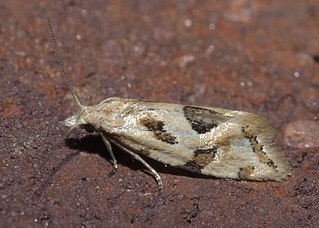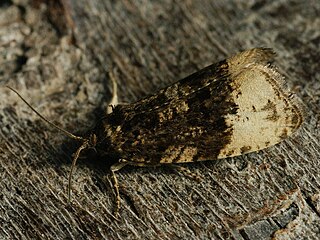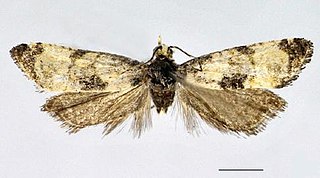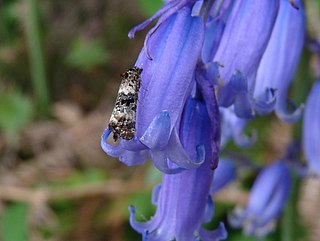
Aethes cnicana is a moth of the family Tortricidae. It was described by Westwood in 1854. It is found in Europe, China, Japan, Korea and Russia.

Notocelia rosaecolana is a moth of the family Tortricidae. It is found in the Palearctic realm, where it has been recorded from China, Mongolia, Korea, Japan, Iran, Central Asia, Russia and Europe.

Epinotia ramella is a moth of the family Tortricidae. It is found in Europe, China, Japan, Russia and Kazakhstan.

Aethes is a genus of moths belonging to the subfamily Tortricinae of the family Tortricidae.

Ditula angustiorana, the red-barred tortrix, is a moth of the family Tortricidae found in Africa, Asia, Europe and North Africa. Other common names are the fruit-tree tortrix and the vine tortrix. The moth was first described by Adrian Hardy Haworth in 1811.

Epinotia nanana, the European spruce needleminer, is a moth of the family Tortricidae. It is found from northern and central Europe to Russia and Mongolia.

Aethes triangulana is a moth of the family Tortricidae. It was described by Treitschke in 1835. It is found from most of Europe to Central Asia, the Amur region, China and Japan.

Olethreutes palustrana is a moth of the family Tortricidae. It is found in most of Europe, except the Iberian Peninsula and the Balkan Peninsula. It is also known from the eastern part of the Palearctic realm and North America. The habitat consists of heathland with scattered trees.

Hedya ochroleucana, the buff-tipped marble or long-cloaked marble, is a moth of the family Tortricidae. It is found in most of Europe, except part of the Balkan Peninsula and Ukraine and east across the Palearctic. It is also present in most of North America.

Cochylichroa atricapitana, the black-headed conch, is a moth of the family Tortricidae. It is found in China (Xinjiang) and the eastern Palearctic and most of Europe.

Cochylis dubitana, the little conch, is a moth of the family Tortricidae. It is found in China (Heilongjiang) and most of Europe. and the Caucasus. It is also found in North America, where it has been recorded from Colorado, Maine, Ontario and Washington.

Ancylis myrtillana is a moth of the family Tortricidae. It was described by Treitschke in 1830. It is found in most of Europe and across the Palearctic.It has also been recorded in North America. The habitat consists of moorland.

Gynnidomorpha alismana, the water plantain conch, is a moth of the family Tortricidae. It was described by Ragonot in 1883. It is found in most of Europe, except Spain, Switzerland, most of the Balkan Peninsula and Ukraine. Further east it is found across the Palearctic to China and Korea. It is found in riverine and other watery habitats.

Cochylis pallidana, the sheep's-bit conch, is a moth of the family Tortricidae. It was described by Zeller in 1847.

Cnephasia longana, the omnivorous leaftier moth, long-winged shade or strawberry fruitworm, is a moth of the family Tortricidae. It was described by Adrian Hardy Haworth in 1811. It is native to western Europe. It is an introduced species in western North America. The species has also been reported from north-western Africa and Asia. The habitat consists of downland and rough ground.

Hysterophora maculosana, the bluebell conch, is a species of moth of the family Tortricidae. It is found from most of Europe, east to the Crimea, Asia Minor and the Palestinian territories. The habitat consists of woodland areas.

Eucosma aspidiscana, the golden-rod bell, is a species of moth of the family Tortricidae. It is found in China, Mongolia, Korea, Japan, Russia, North Africa and most of Europe. The habitat consists of woodlands, downland, waste grounds and cliffs.

Eucosma cana, the hoary bell, is a species of moth of the family Tortricidae.

Epinotia subocellana is a species of moth of the family Tortricidae. It is found in Asia and Europe and was first described by Edward Donovan in 1806.

Epinotia abbreviana is a moth of the family Tortricidae. It is found in Europe and was first described by Johan Christian Fabricius in 1794.





















